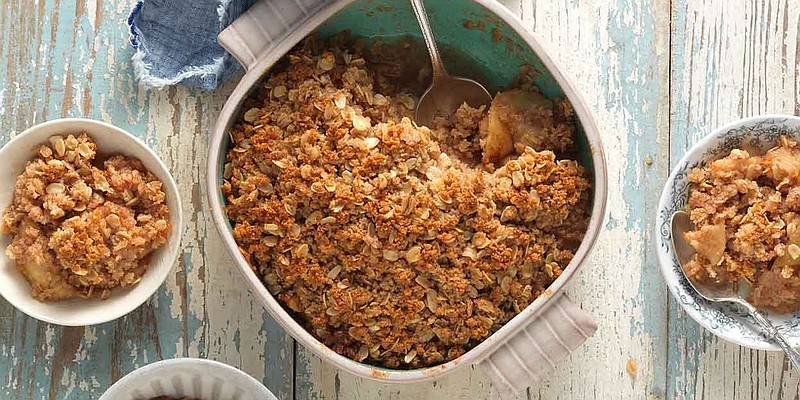Quick tips
Victoria Behm offers these suggestions:* Be aware that the most-common allergens: gluten (in wheat, rye, barley), dairy, eggs, shellfish, peanuts, tree nuts and soy.* Use culinary (canned) coconut milk instead of milk.* Instead of butter, use coconut oil or ghee, which is lactose-free, clarified butter that’s low in casein (the protein that triggers an allergic reaction).* Make dairy-free cream of mushroom with coconut milk and gluten-free thickeners like arrowroot.* Buy gluten-free bread for stuffing.* Make mashed cauliflower instead of mashed potatoes.* Replace refined sugars with alternatives like honey, grade-B maple syrup, molasses or zero-calorie sweeteners like xylitol and stevia.* Make sure all utensils and equipment are clean and have not been used to prepare an allergen-containing dish before using them again. When in doubt, just grab a new spoon.
If you go
› What: Healthy for the Holidays: Revamping Holiday Favorites› When: 6-8 p.m. Thursday› Where: Dish T’Pass, 302 W. Sixth Street› Cost: $29.50 plus $2.59 ticketing fee› Information: 413-8978 or info@thechattery.org
The turkey is on the table, all golden and smelling like Thanksgiving. Cornbread stuffing steams in a pan nearby.
Alongside it is green bean casserole, the kind made with cream of mushroom soup and french-fried onion rings on top. For dessert, peanut butter pie rests on the kitchen counter, waiting to be sliced and dolloped with real whipped cream.
Wait a second. Did anyone think about Uncle Frank's gluten intolerance? And Cousin Mike is a vegan, isn't he? And for heaven's sake, doesn't Aunt Tess have a nut allergy so severe that one peanut can send her to the hospital?
For some families, Thanksgiving dinner is not just a meal; it's a tap dance through a minefield of food allergies, intolerant digestive systems and personal lifestyle choices.
Victoria Yunez Behm understands both sides of the equation, from the cookers to the eaters. With a master's of science in nutrition and integrative health from the Maryland University of Integrative Health, she knows food is central to a happy Thanksgiving, but she also knows it can hold special fear for those who can't eat certain dishes that are often part of the feast.
"People with dietary restrictions often feel very misunderstood or even outright criticized at family meals, and I just don't think it's fair to blame that person for their nutritional choices or requirements," she says.
"Many people bring their own food to avoid cross-contamination or just don't eat during the meal, which leaves them out of a very important social and family ritual and also leaves them hungry."
From the other side, though, "some people may be faced with planning a menu that serves a gluten-free person, a vegetarian/vegan person, someone who can't have dairy, etc. Well, there goes the turkey, the stuffing, the gravy and the potatoes!"
To help navigate the maze, on Thursday Behm is teaching a class called "Healthy for the Holidays: Revamping Holiday Favorites." She's not trying to take the fun and tradition out of Thanksgiving, she says. Instead, it's about "rethinking" the meal.
"Thanksgiving is a family meal and food is central, so I really want to equip cooks with some options and ideas for making this work for everyone who sits at their table," she says. "So the question I want to answer for this class is: 'How can we add to the table for our family members with different diets instead of taking away?'"
For those with dietary restrictions, the common holiday theme of "eat this, drink this, just try it" can be scary, she says. One way to avoid problems is to go potluck, with everyone bringing their own dish.
"People with special diets can bring something that works for them - and maybe convince a few other people to pitch in, too," Behm says. "Whether potluck style or not, one of the really nice things you can do is just list the ingredients in the dish on a little note card and put it beside the food so people can decide for themselves whether or not they want to eat it."
When it comes to preparing healthy dishes, she says, the work begins even before Thanksgiving cooks enter the kitchen. The key is starting with quality ingredients and, no, that doesn't mean taking out a loan to buy organic food or cutting out everything that tastes good.
"Most people are just buying poor-quality foods," she says. "Choose organic when you can, eat real food that's in season, eat lots of colorful fruits and veggies, eat fewer - or no - refined carbohydrates, healthy fats, grass-fed and organic meats, drink lots of clean water."
Nothing new here, she admits, but many folks don't follow these tips "largely due to misinformation, perceived lack of time and the misconception that 'healthy' food is necessarily costly." Sure, she says, you can drop $20 on a jar of cashew butter if you want, but you don't have to spend that kind of money to find quality food.
In the end, however, don't let the fear put a cloud over your Thanksgiving meal, she insists.
"To be honest, holiday meals are often a little bit healthier than what the average American eats on a day-to-day basis. Anything that's homemade with love is generally going to be a better option than something prepackaged or made at a poor-quality restaurant," Behm says.
"But for those people who really want to step up their game, my best advice is to source high-quality ingredients and enjoy time cooking and eating with your loved ones, knowing that you're nourishing them at the most fundamental level."
Contact Shawn Ryan at sryan@timesfreepress.com or 423-757-6327.
